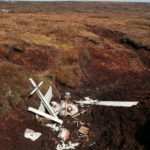USAAF Boeing B17G 43-38944, Cheshire
‹ Return to Air Crash Sites

On January 2nd 1945, a brand new Flying Fortress was being delivered from the American air depot at Burtonwood near Warrington, to a bomber squadron at RAF Nuthampstead in Hertfodrshire.
The pilot had not gained sufficient height to cross the last hills of the Pennines however, and struck the ground at Birchenough Hill near the village of Wildboarclough with the loss of all on board.
The photo above shows a memorial plaque with a stone placed above. It is a few metres from the actual crash site and a hundred metres or so from where the wreck came to rest and burned.
Crew
First Lieutenant Donald James DeCleene. Pilot.
Second Lieutenant Maynard Stravinski. Co-pilot
Flight Officer Thomas Manos. Navigator
Technical Sergeant Howard F Ayres. Radio Operator
Technical Sergeant Frank E Garry. Flight Engineer
Details from
Peakland Air Crashes- The Central Area, P Cunningham. 2006
see also
www.flickr.com/photos/maycontaintracesofnuts/4238032754/i…
9 comments on “USAAF Boeing B17G 43-38944, Cheshire”
Leave a Reply to Anonymous Cancel reply
Image Information
-
Full Size: 740×1113px
Aperture: f/5.6
Focal Length: 18mm
ISO: 200
Shutter: 1/125 sec
Camera: NIKON D40



The largely Australian crewed Lancaster bomber NF908 crashed the day after at this spot, just a few miles to the south, again with the tragic loss of all crew members.
[http://www.flickr.com/photos/maycontaintracesofnuts/4237133277/]
love the sky 🙂
love the sky 🙂
What a tragic couple of days .
Very well shot as always Ian
I wonder if there is a ‘black’ spot for air crashes around there??
very moving story and photos ian as always
good grief – why weren’t they makin it over the hill?? were they fully loaded and not climbin cos of bad January weather? i mean, it’s not like the hills ever change their height.. the lack of anything decent [instruments / navaids] and the fact that they had to push on it all sorts of ridiculous conditions well, gosh it really just makes me a bit grrr. … esp. that these are 1945 crashes, so close to the end of the war and not like the start, where Bomber Command was still in its ‘learning’ phase.
o. and fab shot. i love the wee contrail intersecting the cloud at alt. .. kind of a nice tribute between airmen.
[http://www.flickr.com/photos/angwickham]
Hi Ang, thanks for all your recent comments, will get round to replying to them all soon!
I will need to look at what I have on this one, but as there were no survivors, I’ll guess the exact reasons will never be known, there may have been a mechanical failure for all I know, it was a new B-17 so may have had problems. Or it was one of or a combination of the usual factors;
1. Crews trained in the US where the weather is less of a daily event than it was for them in the UK, misjudged the conditions.
2. End of the war = crews had their guard down, wwere excited about going home and, like mountaineers on their way down, more prone therefore to making an error. We seem to visit more wreck sites dating back to 1945 than any other year.
3. The usual lack of altimeters because they never existed then, coupled with an ignorance of high ground along the route which is down to bad planning.
But as I say, we don’t really know, it could have been something mechanical.